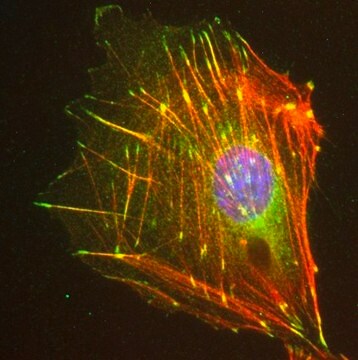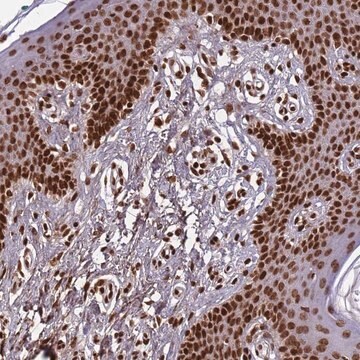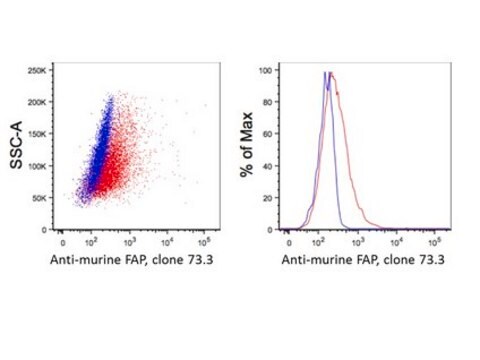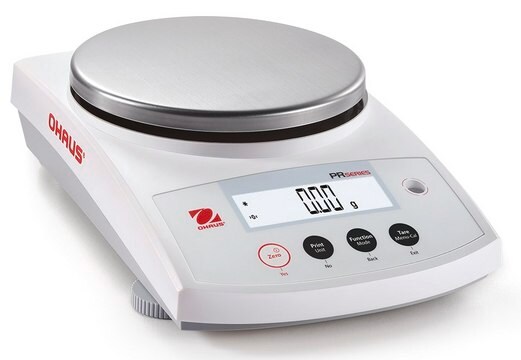ABC1463
Ant-Zyxin
Anti-Zyxin Antibody, Cat. No. ABC1463 is a rabbit polyclonal antibody that detects Zyxin and has been tested for use in Immunocytochemistry and Western Blotting.
Synonym(e):
Zyxin-2
Anmeldenzur Ansicht organisationsspezifischer und vertraglich vereinbarter Preise
Alle Fotos(1)
About This Item
UNSPSC-Code:
12352203
eCl@ss:
32160702
NACRES:
NA.43
Empfohlene Produkte
Allgemeine Beschreibung
Zyxin (UniProt: Q15942; also known as Zyxin-2) is encoded by the ZYX gene (Gene ID: 7791) in human. Zyxin is an evolutionarily conserved LIM domain protein that acts as an adhesion plaque protein concentrated at sites of cell adhesion and is widely expressed. It has been implicated in cell adhesion, cell motility, and signaling. Zyxin is reported to associate with members of the Enabled (Ena)/vasodilator-stimulated phosphoprotein (VASP) family of cytoskeletal regulators and plays a role in cytoskeletal dynamics and signaling. Zyxin contains three LIM zinc binding domains (aa 384-443; 444-503; and 504-570), which act as a negative regulator of Zyxin-VASP complexes. Also, it contains four proline rich ActA repeats (aa 64-77; 94-108; 115-121; and 127-137) that are known to interact directly with Ena/VASP proteins. Loss of Zyxin results in inability to thicken stress fibers in response to mechanical stimuli. (Ref.: Hoffman LM et al (2003). Mol. Cell Biol. 23(1); 70-79; Moody JD et al. (2009). Biochem. Biophys. Res. Commun. 378(3), 625-628; Yoshigi et al (2005). J. Cell Biol. 171(2), 209-215.).
Spezifität
This rabbit polyclonal antibody detects Zyxin in human, mouse, and chicken cells. It targets an epitope within 20 amino acids from the C-terminal half.
Immunogen
Epitope: unknown
KLH-conjugated linear peptide corresponding to 20 amino acids from the C-terminal half of human Zyxin.
Anwendung
Research Category
Zellstruktur
Zellstruktur
Western Blotting Analysis: A 1:1,000 dilution from a representative lot detected Zyxin in A431 cell lysate.
Immunofluorescence Analysis: A representative lot detected Zyxin in newborn mouse skin. Hoffman, L.M., et. al. (2003). Mol Cell Biol. 23(1):70-9; Hoffman, L.M., et. al. (2012). Mol Biol Cell. 23(10):1846-59).
Western Blotting Analysis): A representative lot detected Zyxin in mouse lung, mouse embryo fibroblasts and in human Ewing sarcoma cells.(Chaturvedi, A., et. al. (2014). Mol Biol Cell. 25(18):2695-709; Hoffman, L.M., et. al. (2003). Mol Cell Biol. 23(1):70-9; Hoffman, L.M., et. al. (2012). Mol Biol Cell. 23(10):1846-59; Hoffman, L.M., et. al. (2006). J Cell Biol. 172(5):771-82).
Immunocytochemistry Analysis: A representative lot detected Zyxin at focal adhesions in mouse fibroblasts and in 4T1 cells with ATG7 shRNA or ATG5 shRNA (Hoffman, L.M., et. al. (2006). J Cell Biol. 172(5):771-82; Sharifi, M.N., et. al. (2016). Cell Rep. 15(8):1660-72).
Immunofluorescence Analysis: A representative lot detected Zyxin in newborn mouse skin. Hoffman, L.M., et. al. (2003). Mol Cell Biol. 23(1):70-9; Hoffman, L.M., et. al. (2012). Mol Biol Cell. 23(10):1846-59).
Western Blotting Analysis): A representative lot detected Zyxin in mouse lung, mouse embryo fibroblasts and in human Ewing sarcoma cells.(Chaturvedi, A., et. al. (2014). Mol Biol Cell. 25(18):2695-709; Hoffman, L.M., et. al. (2003). Mol Cell Biol. 23(1):70-9; Hoffman, L.M., et. al. (2012). Mol Biol Cell. 23(10):1846-59; Hoffman, L.M., et. al. (2006). J Cell Biol. 172(5):771-82).
Immunocytochemistry Analysis: A representative lot detected Zyxin at focal adhesions in mouse fibroblasts and in 4T1 cells with ATG7 shRNA or ATG5 shRNA (Hoffman, L.M., et. al. (2006). J Cell Biol. 172(5):771-82; Sharifi, M.N., et. al. (2016). Cell Rep. 15(8):1660-72).
Qualität
Evaluated by Western Blotting in NIH3T3 cell lysate.
Western Blotting Analysis: A 1:5,000 dilution of this antibody detected Zyxin in NIH3T3 cell lysate.
Western Blotting Analysis: A 1:5,000 dilution of this antibody detected Zyxin in NIH3T3 cell lysate.
Zielbeschreibung
~75 kDa observed; 61.28 kDa calculated. Uncharacterized bands may be observed in some lysate(s).
Physikalische Form
Unpurified
Rabbit polyclonal antiserum with 0.05% sodium azide.
Lagerung und Haltbarkeit
Stable for 1 year at -20°C from date of receipt.
Handling Recommendations: Upon receipt and prior to removing the cap, centrifuge the vial and gently mix the solution. Aliquot into microcentrifuge tubes and store at -20°C. Avoid repeated freeze/thaw cycles, which may damage IgG and affect product performance.
Handling Recommendations: Upon receipt and prior to removing the cap, centrifuge the vial and gently mix the solution. Aliquot into microcentrifuge tubes and store at -20°C. Avoid repeated freeze/thaw cycles, which may damage IgG and affect product performance.
Sonstige Hinweise
Concentration: Please refer to lot specific datasheet.
Haftungsausschluss
Unless otherwise stated in our catalog or other company documentation accompanying the product(s), our products are intended for research use only and are not to be used for any other purpose, which includes but is not limited to, unauthorized commercial uses, in vitro diagnostic uses, ex vivo or in vivo therapeutic uses or any type of consumption or application to humans or animals.
Analysenzertifikate (COA)
Suchen Sie nach Analysenzertifikate (COA), indem Sie die Lot-/Chargennummer des Produkts eingeben. Lot- und Chargennummern sind auf dem Produktetikett hinter den Wörtern ‘Lot’ oder ‘Batch’ (Lot oder Charge) zu finden.
Besitzen Sie dieses Produkt bereits?
In der Dokumentenbibliothek finden Sie die Dokumentation zu den Produkten, die Sie kürzlich erworben haben.
Unser Team von Wissenschaftlern verfügt über Erfahrung in allen Forschungsbereichen einschließlich Life Science, Materialwissenschaften, chemischer Synthese, Chromatographie, Analytik und vielen mehr..
Setzen Sie sich mit dem technischen Dienst in Verbindung.








